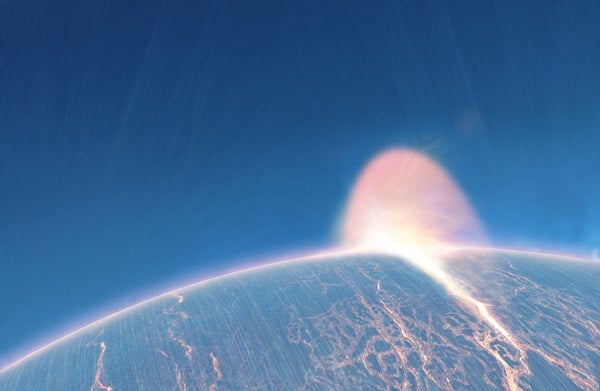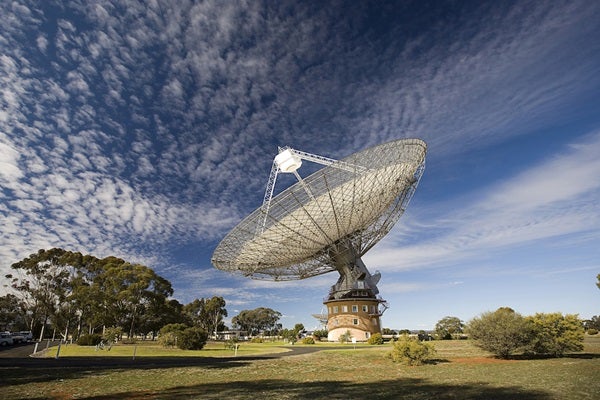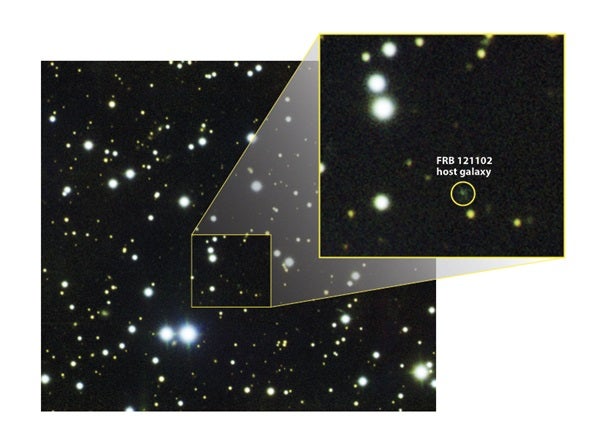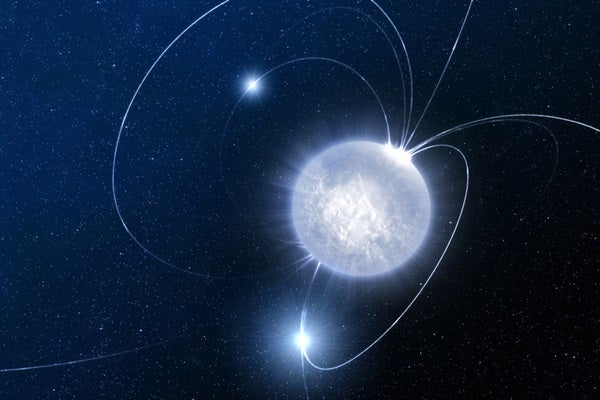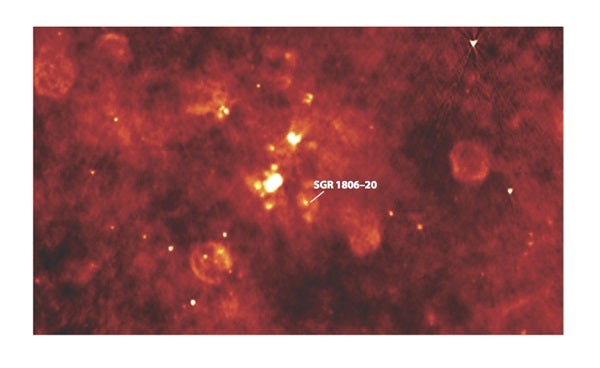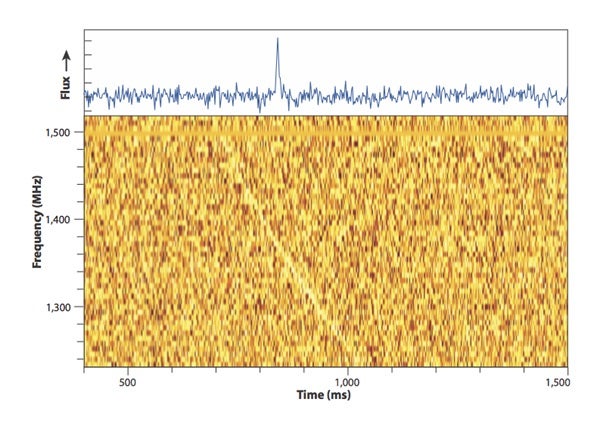It’s been 10 years since the first FRB discovery. It’s generated so much buzz that in 2017, a few dozen astronomers held the first conference on FRBs, and millions of dollars in funding have been devoted to finding more. But as more bursts come in, the mystery has only deepened. To travel the distance between galaxies, FRBs must have an insane amount of energy — in the few brief milliseconds it shines, an FRB can generate more energy than the Sun does in a day. And yet despite the tremendous energy, no one has a clue about where they come from.
What we know
So far, we’ve seen 33 bursts, and they last a few milliseconds at most. We know they are, for that brief period, one of the brightest radio sources in our sky, and they have been identified in all areas of the sky, rather than originating in a single direction. But astronomers are cautious about drawing many conclusions from such a small sample as we have now.
We know FRBs come from beyond the galaxy. This distance information is based on a radio astronomy trick relying on the fact that space is not a perfect vacuum — while it is better than any vacuum on Earth, even the void between galaxies has a few hydrogen atoms per cubic meter. Radio waves traveling through space from a single source will interact with those few atoms’ electrons they pass, causing a slight delay in the waves depending on their frequency. Measuring this exact delay, known as the dispersion measure (DM), can tell you how much material the signal has passed through. A higher DM means a signal has traveled a greater distance, and the FRB DMs are decidedly extragalactic.
But things get weirder from there. So far, only one FRB repeats, despite many hours of follow-up observations. This exception is FRB 121102, the “repeater,” as astronomers colloquially call it. Arecibo Observatory in Puerto Rico first detected it November 2, 2012 (hence its name). Since then, astronomers have observed periods of calm where nothing is seen for months at a time from this source, and periods of outburst where it gives off over two dozen bursts in two hours, with no distinguishable pattern. No one knows whether the repeater is a type of FRB different from the others, or if all FRBs repeat and the Arecibo Observatory’s 1,000-foot (305 meters) radio dish is the only telescope sensitive enough to easily find repeating bursts.
The repeater has been crucial in providing the first clues on where FRBs come from. Radio waves differ greatly from visible light. The wavelength of light varies from 400 nanometers (violet) to 700 nm (red); a nanometer is one-billionth of a meter, or 40-billionths of an inch. But radio waves can vary from a millimeter to hundreds of meters in length.
This has important applications for the telescopes astronomers use because the angular resolution of a telescope on the sky — that is, the level of detail the telescope can see — depends on the wavelength of light observed and the diameter of the telescope. Point a 1-meter optical telescope on the sky, and its diameter is 2 million times bigger than the light waves it observes, and its resolution is 0.3″ or 1/12,000°. On the other hand, a radio telescope with a 210-foot (64 meters) dish — the diameter of Parkes Observatory, which has discovered the majority of FRBs — will yield a resolution of 900″ (¼°), about half the diameter of the Full Moon in the sky. That area may sound small, but it’s enough to hold hundreds or even thousands of distant sources. Because of this, a definitive identification of an FRB’s origin with a single-dish telescope like Parkes or Arecibo is impossible.
Luckily, astronomers have a few tricks to get around the resolution problem. The first is to link multiple radio telescopes together in a technique known as interferometry. By combining simultaneous observations from multiple telescopes, astronomers effectively create a radio telescope with a diameter equal to the distance between dishes.
Interferometry can be carried out using telescopes thousands of miles apart, giving resolutions down to 10-millionths of a degree. You wouldn’t want to do a survey for new objects with such a small field of view on the sky — an FRB could be going off less than a Moon-width away, and you’d never know — but it is a wonderful technique for pinpointing a single signal like the FRB repeater.
Using such an interferometer — the Karl G. Jansky Very Large Array (VLA), consisting of twenty-seven 28-foot (25 m) dishes in New Mexico — astronomers in fall 2016 detected several outbursts from the repeating FRB 121102. This allowed them to narrow down its area of origin and make detailed radio images of the region with other telescopes — as well as image it in optical light using the Gemini North Telescope in Hawaii — to identify the source of the repeater.
What the team found was a surprise. The repeater appears to originate from a dwarf galaxy 3 billion light-years away, which would appear completely uninteresting if something weren’t repeatedly throwing out insane amounts of radio energy. The galaxy is about the size of the Small Magellanic Cloud, a satellite galaxy of the Milky Way with about 1 percent the mass of our own. Astronomers used the Hubble Space Telescope and the Spitzer Space Telescope for further follow-up, and it appears the bursts originate from a star-forming region on the outskirts of its host galaxy. No one knows the source more specifically than that, but the bursts keep coming from that location — over 150 of them at last count.
The mystery remains
One popular theory for the repeater, at least, suggests the bursts originate from a magnetar, a neutron star dominated by an extremely strong magnetic field. A magnetar’s field can be so powerful that even at more than 600 miles (1,000 kilometers) away, it alone would kill you by compressing the electron clouds in your atoms. They are also known to give off enormous bursts of high-energy radiation. In 2004, a magnetar called SGR 1806–20 experienced a starquake, or tiny shift in its crust, that shook its magnetic field so violently that the event would have registered as a 23 on the Richter scale. (By comparison, the 2004 Boxing Day tsunami in Indonesia was triggered by an earthquake registering 9.1 on this scale.) Even though SGR 1806–20 is 50,000 light-years away, the tremor caused a 0.2-second flare brighter than the Full Moon. It knocked research and communication satellites briefly offline and temporarily altered the shape of Earth’s upper atmosphere. The burst had enough energy in it to power the Sun for 150,000 years and could have caused billions of dollars in damage had the magnetar been closer.
Supernovae are rare events. A Milky Way-sized galaxy averages one such explosion per century, and none has been recorded in our galaxy since the invention of the telescope. But one of the brightest radio sources in the sky is the Crab Pulsar, known to give off random giant pulses lasting a fraction of a nanosecond and suddenly exceeding the brightness of normal pulses by a factor of several thousand. And we happen to know its age: The Crab Pulsar was created in a supernova explosion recorded as a “guest star” in A.D. 1054 by Chinese astronomers, so bright it was visible in daytime. Could FRBs be caused by similar giant pulses from even younger pulsars, just a few decades old? No one knows.
Finally, FRBs could come from more than one source. The field of gamma-ray bursts (GRBs) is an example of how this scenario could play out. U.S. military satellites designed to detect gamma radiation from nuclear weapons tests first observed GRBs in the 1960s; the existence of GRBs from deep space was declassified in 1973. By 1994, no fewer than 128 models of GRBs were published, many of which were quickly discarded when a newly discovered GRB didn’t fit the bill. In the end, however, this was hasty because it turns out GRBs from deep space fall into two major categories (and a few more rare ones). About 70 percent of all GRBs are so-called long GRBs, which occur when a supermassive star at the end of its life explodes as a supernova and subsequently forms a new black hole. The remaining category is made up of short GRBs, which originate when two neutron stars merge. These were confirmed in October 2017 by the gravitational wave detector LIGO and telescope follow-up.
Aiming for answers
Many groups are interested in contributing to that FRB snowbank, with new instruments and telescopes under development to search for them. One of the standouts is the Canadian Hydrogen Intensity Mapping Experiment (CHIME), predicted to spot as many as several dozen FRB signals each day. As the name implies, CHIME was not initially conceived as an FRB-detecting machine — its primary science goal is to precisely map hydrogen in distant galaxies to learn about the expansion history and acceleration of the universe. But it does have an ideal field of view for FRB hunting, and when Victoria Kaspi of McGill University heard about the first FRBs, she acquired funding to look for them as well. “I was first thinking about pulsars,” Kaspi confesses, “but it soon became clear that CHIME would be ideal for FRBs.”
Yvette Cendes is a radio astronomer at the Dunlap Institute for Astronomy and Astrophysics, University of Toronto. Her website is www.yvettecendes.com

